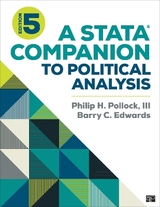
A Stata® Companion to Political Analysis
Cq Press (Verlag)
978-1-5063-7970-8 (ISBN)
—Sabri Ciftci, Kansas State University
Popular for its speed, flexibility, and attractive graphics, Stata is a powerful tool for political science students. With Philip Pollock′s Fourth Edition of A Stata® Companion to Political Analysis, students quickly learn Stata via step-by-step instruction, more than 50 exercises, customized datasets, annotated screen shots, boxes that highlight Stata′s special capabilities, and guidance on using Stata to read raw data. This attractive and value-priced workbook, an ideal complement to Pollock’s Essentials of Political Analysis, is a must-have for any political science student working with Stata.
Give your students the SAGE edge!
SAGE edge offers a robust online environment featuring an impressive array of free tools and resources for review, study, and further exploration, keeping both instructors and students on the cutting edge of teaching and learning.
Philip H. Pollock III is a professor of political science at the University of Central Florida. He has taught courses in research methods at the undergraduate and graduate levels for more than thirty years. His main research interests are American public opinion, voting behavior, techniques of quantitative analysis, and the scholarship of teaching and learning. His recent research has been on the effectiveness of Internet-based instruction. Pollock’s research has appeared in the American Journal of Political Science, Social Science Quarterly, and the British Journal of Political Science. Recent scholarly publications include articles in Political Research Quarterly, the Journal of Political Science Education, and PS: Political Science and Politics. Barry C. Edwards writes textbooks and works for Fair Trial Analysis, LLC, a company that conducts research on juries and jurors for civil and criminal litigation. He received his B.A. from Stanford University, a J.D. from New York University, and a Ph.D. from the University of Georgia. He taught survey design and analysis, research methods, and prelaw courses at the University of Central Florida and continues to teach occasional courses for the University of Georgia. His political science interests include American politics, public law, and research methods. He founded the Political Science Data Group and created the PoliSciData.com website. His research has been published in American Politics Research, Congress & the Presidency, Election Law Journal, Emory Law Journal, Georgia Bar Journal, Harvard Negotiation Law Review, Journal of Politics, NYU Journal of Legislation and Public Policy, Political Research Quarterly, Presidential Studies Quarterly, Public Management Review, State Politics and Policy Quarterly, and UCLA Criminal Justice Law Review.
Figures and Tables
Preface
Introduction: Getting Started
About Companion Datasets
Chapter 1 Introduction to Stata
Information About a Dataset
Information About Variables
General Syntax of Stata Commands
Do-files
Printing Results and Copying Output
Log Files
Getting Help
Customizing Your Display
Exercises
Chapter 2 Descriptive Statistics
Interpreting Measures of Central Tendency and Variation
Describing Nominal Variables
A CLOSER LOOK: Weighting the GSS and NES Datasets
Describing Ordinal Variables
Describing Interval Variables
Bar Charts for Nominal and Ordinal Variables
A CLOSER LOOK: Stata’s Graphics Editor
Histograms for Interval Variables
Obtaining Case-Level Information With sort and list
Exercises
Chapter 3 Transforming Variables
Creating Indicator Variables
Working With Variable Labels
Collapsing Variables Into Simplified Categories
Centering or Standardizing a Numeric Variable
Creating an Additive Index
Exercises
Chapter 4 Making Comparisons
Cross-Tabulation Analysis
Visualizing Comparisons With Nominal or Ordinal Dependent Variables
A CLOSER LOOK: The replace Command
Mean Comparison Analysis
A CLOSER LOOK: The format Command
Visualizing Comparisons With Interval-Level Dependent Variables
Strip Charts: Graphs for Small-N Datasets
Exercises
Chapter 5 Making Controlled Comparisons
Cross-Tabulation Analysis With a Control Variable
A CLOSER LOOK: The “If ” Qualifier
Visualizing Controlled Comparisons With Categorical Dependent Variables
Mean Comparison Analysis With a Control Variable
Visualizing Controlled Mean Comparisons
Exercises
Chapter 6 Making Inferences About Sample Means
Finding the 95 Percent Confidence Interval of a Sample Mean
Testing a Hypothetical Claim About the Population Mean
Testing the Difference Between Two Sample Means
A CLOSER LOOK: Inferences About Means With Unweighted Data
Extending the mean and lincom Commands to Other Situations
Making Inferences About Sample Proportions
A CLOSER LOOK: Inferences About Proportions With Unweighted Data
Exercises
Chapter 7 Chi-Square and Measures of Association
Analyzing Ordinal-Level Relationships
A CLOSER LOOK: Analyzing Unweighted Data With The tabulate Command
Analyzing an Ordinal-Level Relationship With a Control Variable
Analyzing Nominal-Level Relationships
Exercises
Chapter 8 Correlation and Linear Regression
Correlation Analysis
Regression Analysis
A CLOSER LOOK: Treating Census as a Sample
A CLOSER LOOK: R-Squared and Adjusted R-Squared: What’s the Difference?
Creating a Scatterplot With a Linear Prediction Line
Multiple Regression
A CLOSER LOOK: Bubble Plots
Correlation and Regression Analysis With Weighted Data
Exercises
Chapter 9 Dummy Variables and Interaction Effects
Regression With Multiple Dummy Variables
Interaction Effects in Multiple Regression
Graphing Linear Prediction Lines for Interaction Relationships
Changing the Reference Category
Exercises
Chapter 10 Logistic Regression
Thinking About Odds, Logged Odds, and Probabilities
Estimating Logistic Regression Models
Logistic Regression With Multiple Independent Variables
A CLOSER LOOK: Comparing Logistic Regression Models With the estimates and lrtest Commands
Graphing Predicted Probabilities With One Independent Variable
Graphing Predicted Probabilities With Multiple Independent Variables
Exercises
Chapter 11 Doing Your Own Political Analysis
Seven Doable Ideas
Importing Data Into Stata
Writing It Up
Appendix
Table A-1: Variables in the GSS Dataset in Alphabetical Order
Table A-2: Variables in the NES Dataset in Alphabetical Order
Table A-3: Variables in the States Dataset by Topic
Table A-4: Variables in the World Dataset by Topic
| Erscheinungsdatum | 01.11.2018 |
|---|---|
| Verlagsort | Washington |
| Sprache | englisch |
| Maße | 215 x 279 mm |
| Gewicht | 740 g |
| Themenwelt | Sozialwissenschaften ► Politik / Verwaltung ► Europäische / Internationale Politik |
| Sozialwissenschaften ► Politik / Verwaltung ► Politische Theorie | |
| ISBN-10 | 1-5063-7970-2 / 1506379702 |
| ISBN-13 | 978-1-5063-7970-8 / 9781506379708 |
| Zustand | Neuware |
| Informationen gemäß Produktsicherheitsverordnung (GPSR) | |
| Haben Sie eine Frage zum Produkt? |
aus dem Bereich



